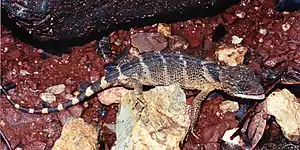Xenosauridae
Xenosauridae is a family of anguimorph lizards whose only living representative is the genus Xenosaurus, which is native to Central America. Xenosauridae also includes the extinct genera Exostinus and Restes. Also known as knob-scaled lizards, they have rounded, bumpy scales and osteoderms. Most living species prefer humid, rocky habitats, although they are widespread within their native regions, with some inhabiting semi-arid scrub environments. They are carnivorous or insectivorous, and give birth to live young.[2]
| Xenosauridae | |
|---|---|
 | |
| Xenosaurus platyceps | |
| Scientific classification | |
| Kingdom: | Animalia |
| Phylum: | Chordata |
| Class: | Reptilia |
| Order: | Squamata |
| Clade: | Carusioidea |
| Family: | Xenosauridae Cope, 1886 |
| Genera | |
| |
Shinisaurus, the Chinese crocodile lizard, was once also regarded as a member of Xenosauridae, but most recent studies of the evolutionary relationships of anguimorphs consider Shinisaurus to be more closely related to monitor lizards and helodermatids than to Xenosaurus.[3] Xenosauridae is part of a larger clade or evolutionary grouping called Carusioidea, which, in addition to xenosaurids, includes the extinct genus Carusia.[4]
References
- "Fossilworks: Xenosauridae".
- Bauer, Aaron M. (1998). Cogger, H.G.; Zweifel, R.G. (eds.). Encyclopedia of Reptiles and Amphibians. San Diego: Academic Press. pp. 159–160. ISBN 0-12-178560-2.
- Bhullar, B. A. S. (2011). "The Power and Utility of Morphological Characters in Systematics: A Fully Resolved Phylogeny of Xenosaurus and Its Fossil Relatives (Squamata: Anguimorpha)". Bulletin of the Museum of Comparative Zoology. 160 (3): 65–181. doi:10.3099/0027-4100-160.3.65. S2CID 86328454.
- Conrad, J. L.; Ast, J. C.; Montanari, S.; Norell, M. A. (2011). "A combined evidence phylogenetic analysis of Anguimorpha (Reptilia: Squamata)". Cladistics. 27 (3): 230–277. doi:10.1111/j.1096-0031.2010.00330.x. S2CID 84301257.